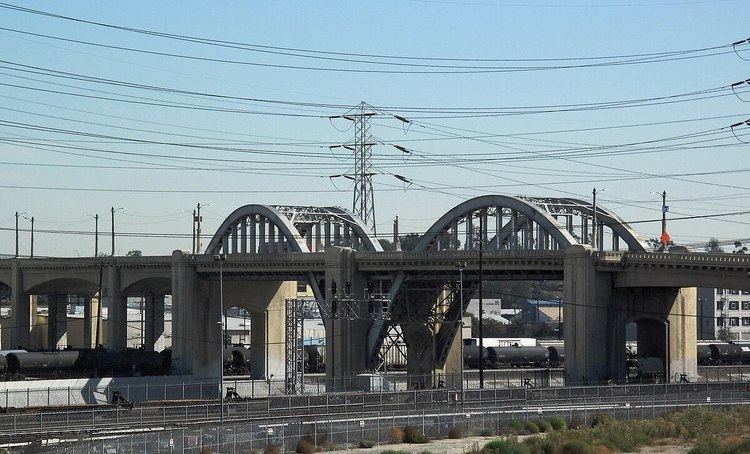Total length 1,067 m | Opened 1932 Bridge type Viaduct | |
 | ||
Crosses Metrolink tracks, Los Angeles River, Union Pacific Railroad tracks, Santa Ana Freeway, Golden State Freeway, several local streets Official name Sixth Street Bridge from the LA River Address E 6th St, Los Angeles, CA 90013, USA Similar 6th St Bridge, Glendale‑Hyperion Bridge, 4th Street Bridge, Vincent Thomas Bridge, Parker Center Profiles | ||
The making of a bridge sixth street viaduct replacement project
The Sixth Street Viaduct, also known as the Sixth Street Bridge, was a viaduct bridge that connected the Arts District in Downtown Los Angeles with the Boyle Heights neighborhood. It spanned the Los Angeles River, the Santa Ana Freeway (US 101), and the Golden State Freeway (I-5), as well as Metrolink and Union Pacific railroad tracks and several local streets. Built in 1932, the viaduct was composed of three independent structures: the reinforced concrete west segment, the central steel arch segment over the river, and the reinforced concrete east segment. In 1986, the Caltrans bridge survey found the Sixth Street Viaduct eligible for inclusion in the National Register of Historic Places.
Contents
- The making of a bridge sixth street viaduct replacement project
- Sixth street viaduct replacement model
- Demolition and replacement
- Cultural depictions
- Music videos
- References
Despite its historical status, the bridge was closed for demolition and replacement in January 2016 due to concerns over seismic instability.
Sixth street viaduct replacement model
Demolition and replacement
During the construction of the viaduct in the 1930s, an onsite plant was used to supply the concrete for construction. However, the quality of the concrete turned out to have a high alkali content and led to an alkali-silica reaction (ASR) which created cracks in the concrete and sapped the strength of the structure. It is the only one of the historic LA River bridges to suffer from ASR.
Estimates stated that the viaduct had a 70% probability of collapse due to a major earthquake within 50 years.
After initial demolition plans were delayed, the bridge was closed on January 27, 2016, and demolition was scheduled to begin on February 5, 2016. An estimated 48,000 cubic yards of concrete, 1,245 tons of structural steel and 4,200 tons of rebar will be hauled away as construction begins on the replacement. The new bridge, designed by architect Michael Maltzan and the HNTB Design-Build team and contractors Skanska and Stacy and Witbeck, is set to be completed in 2019. It is expected that it will take nine months to demolish the existing bridge. City leaders are also looking into building parks and plazas around the newly built bridge.
Prior to the demolition, Los Angeles mayor Eric Garcetti recorded the rap song "101SlowJam", backed by musicians from the city's Roosevelt High School, and issued it via a video on his own YouTube channel. The public service announcement video advertised the closure of parts of the 101 Freeway to accommodate the demolition of the viaduct.
Cultural depictions
The bridge is a well-known local landmark, and has appeared in numerous films, television shows, music videos and video games since 1932.
